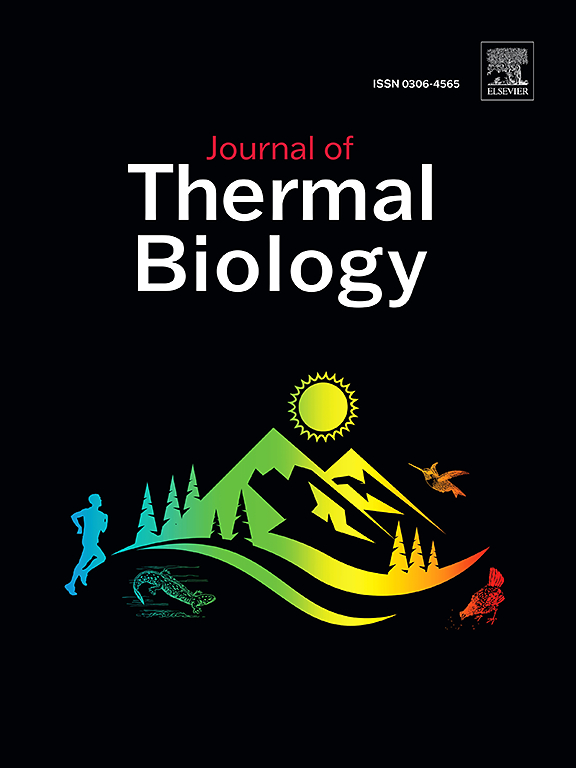Effects of acute high-temperature on gill tissue structure, serum biochemical indices, antioxidant capacity and liver transcriptomics of Thamnaconus septentrionalis
IF 2.9
2区 生物学
Q2 BIOLOGY
引用次数: 0
Abstract
As global extreme heat events become more frequent, aquaculture faces significant challenges due to prolonged high summer temperatures, which lead to elevated water temperatures. Investigating the physiological and biochemical responses of fish to thermal stress, as well as breeding heat-resistant varieties, are essential strategies for addressing these challenges. Thamnaconus septentrionalis is an important aquaculture species in southern China. When water temperatures exceed 30 °C during the summer, this species experiences reduced feeding, growth stagnation, and increased mortality rates. To elucidate the physiological and biochemical response mechanisms of T. septentrionalis under thermal stress, this study established a high-temperature group (30 °C) and a control group (20 °C) for a 48-h thermal stress experiment. Tissue samples were collected from the experimental fish at 0, 12, 24, and 48 h post-stress. The effects of acute thermal stress on gill tissue structure, serum biochemical indicators, liver antioxidant capacity, and liver transcriptomics were explored. The results revealed that the gill tissues of the high-temperature group exhibited slight bending of the gill filaments, terminal swelling, and cellular vacuolization, along with a tendency for adjacent gill filaments to fuse. The liver antioxidant capacity and serum biochemical indicators in the high-temperature group were significantly elevated compared to the control group (P < 0.05). Transcriptomic sequencing identified 5536 differentially expressed genes (P < 0.05), with 2639 genes upregulated and 2897 downregulated. Gene Ontology (GO) enrichment analysis indicated that differentially expressed genes were primarily associated with metabolic processes and redox reactions. KEGG pathway analysis showed significant enrichment of genes in pathways related to amino acid metabolism, carbon metabolism, and glycolysis/gluconeogenesis, with notable downregulation observed in the high-temperature group. This study provides valuable theoretical insights into the mechanisms underlying the response of T. septentrionalis to high-temperature stress, contributing to the understanding of aquaculture resilience in the face of climate change.
急性高温对七爪鲑鳃组织结构、血清生化指标、抗氧化能力和肝脏转录组学的影响
随着全球极端高温事件变得越来越频繁,由于夏季持续高温导致水温升高,水产养殖面临重大挑战。研究鱼类对热胁迫的生理生化反应,以及培育耐热品种,是应对这些挑战的重要策略。七三角鲑(Thamnaconus septentrionalis)是中国南方重要的养殖品种。当夏季水温超过30°C时,该物种的摄食减少,生长停滞,死亡率增加。为了阐明七叶螟在热胁迫下的生理生化反应机制,本研究建立高温组(30℃)和对照组(20℃)进行48 h的热应激实验。分别于应激后0、12、24和48 h采集实验鱼的组织样本。探讨急性热应激对鳃组织结构、血清生化指标、肝脏抗氧化能力和肝脏转录组学的影响。结果表明,高温组鳃组织表现为鳃丝轻微弯曲,末端肿胀,细胞空泡化,并有相邻鳃丝融合的趋势。高温组肝脏抗氧化能力和血清生化指标均显著高于对照组(P <;0.05)。转录组测序鉴定出5536个差异表达基因(P <;0.05),上调基因2639个,下调基因2897个。基因本体(GO)富集分析表明,差异表达基因主要与代谢过程和氧化还原反应有关。KEGG通路分析显示,氨基酸代谢、碳代谢和糖酵解/糖异生相关通路基因显著富集,高温组基因显著下调。本研究为七氏绦虫(T. septentrionalis)对高温胁迫的响应机制提供了有价值的理论见解,有助于理解面对气候变化的水产养殖复原力。
本文章由计算机程序翻译,如有差异,请以英文原文为准。
求助全文
约1分钟内获得全文
求助全文
来源期刊

Journal of thermal biology
生物-动物学
CiteScore
5.30
自引率
7.40%
发文量
196
审稿时长
14.5 weeks
期刊介绍:
The Journal of Thermal Biology publishes articles that advance our knowledge on the ways and mechanisms through which temperature affects man and animals. This includes studies of their responses to these effects and on the ecological consequences. Directly relevant to this theme are:
• The mechanisms of thermal limitation, heat and cold injury, and the resistance of organisms to extremes of temperature
• The mechanisms involved in acclimation, acclimatization and evolutionary adaptation to temperature
• Mechanisms underlying the patterns of hibernation, torpor, dormancy, aestivation and diapause
• Effects of temperature on reproduction and development, growth, ageing and life-span
• Studies on modelling heat transfer between organisms and their environment
• The contributions of temperature to effects of climate change on animal species and man
• Studies of conservation biology and physiology related to temperature
• Behavioural and physiological regulation of body temperature including its pathophysiology and fever
• Medical applications of hypo- and hyperthermia
Article types:
• Original articles
• Review articles
 求助内容:
求助内容: 应助结果提醒方式:
应助结果提醒方式:


